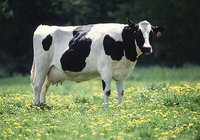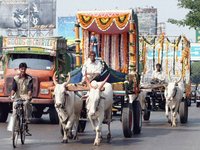Cattle
|
|
| Cattle | ||||||||||||||||
|---|---|---|---|---|---|---|---|---|---|---|---|---|---|---|---|---|
| Missing image Cow_with_calf.jpg Cow with calf Cow with calf | ||||||||||||||||
| Scientific classification | ||||||||||||||||
| ||||||||||||||||
| Binomial name | ||||||||||||||||
| Bos taurus Linnaeus, 1758 |
Cattle are domesticated ungulates, a member of the subfamily Bovinae of the family Bovidae. They are raised as livestock for meat (called beef and veal), dairy products (milk), leather and as draught animals (pulling carts, plows and the like). In some countries, such as India, they are subject to religious ceremonies and respect.
Cattle were originally identified by Carolus Linnaeus as three separate species. These were Bos taurus, the European cattle, including similar types from Africa and Asia; Bos indicus, the zebu; and the extinct Bos primigenius, the aurochs. The aurochs is ancestral to both zebu and European cattle. More recently these three have increasingly been grouped as one species, sometimes using the names Bos primigenius taurus, Bos primigenius indicus and Bos primigenius primigenius. Complicating the matter is the ability of cattle to interbreed with other closely related species. Hybrid individuals and even breeds exist, not only between European cattle and zebu but also with yaks, banteng, gaur, and bison, a cross-genera hybrid. For example, genetic testing of the Dwarf Lulu breed, the only humpless "Bos taurus-type" cattle in Nepal, found them to be a mix of European cattle, zebu and yak. Cattle cannot successfully be bred with water buffalo or African buffalo. (See aurochs for the history of domestication, and zebu for pecularities of that group.)
| Contents |
Terminology
Young cattle are called calves. A young male is called a bull-calf; a young female is called a heifer (pronounced "heffer"). Male cattle bred for meat are castrated unless needed for breeding. The castrated male is then called a bullock or steer, unless kept for draft purposes, in which case it is called an ox (not to be confused with the related wild musk ox). An intact male is called a bull. An adult female over two years of age (approximately) is called a cow. The adjective applying to cattle is bovine.
There is no singular equivalent to "cattle" other than the various gender and age-specific terms (though "catron" is occasionally seen as a half-serious proposal). "Cow" is probably the closest to being gender-neutral, although it is usually understood to mean female (females of other animals, such as whales or elephants, are also called cows.) Some Australian, Canadian, New Zealand and Scottish farmers use the term "cattlebeast". "Neat" (horned oxen, from which we get "neatsfoot oil"), "beef" (young ox) and "beefing" (young animal fit for slaughtering) are obsolete terms. Cattle raised for human consumption are called beef cattle. Cows of certain breeds that are kept for the milk they give are called dairy cows. Herds are counted as, for example, "one hundred head". The term cattle itself is not a plural, but a mass noun. Thus one may refer to some cattle, but not three cattle.
The terms bull and cow are also used for the male and female of some other species, including other bovids such as American Bison, but also less closely related species such as moose, elk, elephants, whales, and sea lions. The terms are used primarily to refer to animals that have polygynous or harem (http://wiktionary.org/wiki/Harem) mating systems, though "bull" in particular may be used because humans find the male of a species daunting.
Biology
Cattle are ruminants, meaning that they have a unique digestive system that allows them to synthesize amino acids. This allows them to thrive on grasses and other vegetation.
Cattle have one stomach, with four compartments. They are the rumen, reticulum, omasum, and abomasum. The rumen is the largest compartment. It can hold up to 40 gallons of digestable feed in a mature cow. The rumen is known as the "Paunch." The reticulum is the smallest compartment. Metal is attracted to the reticulum, and this is where Hardware Disease occurs. The reticulum is known as the "Honeycomb." The omasum's main function is to absorb water and nutrients from the digestable feed. The omasum is known as the "Many Plies." The abomasum is most like the human stomach; this is why it is known as the "True Stomach."
The aurochs was originally spread throughout Europe, Africa and Asia. In historical times, their range was restricted to Europe, and the last animals were killed by poachers in Masovia, Poland, in 1627, although some breeders have attempted to recreate the original gene pool of the aurochs by careful crossing of commercial breeds, creating the Heck cattle breed.
A popular misconception about cattle (primarily bulls) is that they are enraged by the colour red. This is incorrect; cattle are totally colour-blind, and can only see in greyscale. The main source of this rumour is the fact that Matadors traditionally use red-coloured capes to provoke bulls into attacking. In fact, the red color is merely traditional; the movement of the cape is the attractant.
Uses of cattle
Cattle occupy a unique role in human history. Some consider them the oldest form of wealth. Their ability to provide meat, dairy and draft while reproducing themselves and eating nothing but grass has furthered human interests dramatically through the millennia.
In Hinduism, the cow is said to be holy (and thus should not be eaten); "The cow is our Mother, for she gives us milk".
In Latin America, Australia and the western North America cattle are grazed on large tracts of rangeland called ranchos, ranches or Stations (Australia).
In Portugal, Spain and some Latin American countries, bulls are used in the sport of bullfighting; in many other countries this is illegal.
The outbreaks of mad cow disease have reduced or prevented some traditional uses of cattle for food, for example the eating of brains or spinal cords.
Ox
Oxen (plural of ox) are cattle trained as draft animals. Often they are adult, castrated males. Usually an ox is over four years old due to the need for training and for time to grow to full size. Oxen are used for plowing, transport, hauling cargo, grain-grinding by trampling or by powering machines, irrigation by powering pumps, and wagon drawing. Oxen were commonly used to skid logs, and sometimes are still in low-impact select-cut logging, in forests.
Contrary to popular American lore, an "ox" is not a unique breed of bovine, nor have any "blue" oxen lived outside the folk tales surrounding Paul Bunyan, the mythical American logger.
An ox is nothing more than a mature bovine with an "education". The education consists of the animal's learning to respond appropriately to the teamster's (ox driver's) commands: in North America such as (1) get up, (2) whoa, (3) back up, (4) gee (turn to the right) and (5) haw (turn to the left).
In addition to intelligence (the ability to learn), American ox trainers favored larger breeds for their ability to do more work; for the same reason, the typical ox is the male of a breed, rather than the smaller female. Also, the gait of the ox is often important to ox trainers, since the speed the animal walks should roughly match the gait of the ox driver who must work with it.
Oxen are most often used in teams of two, paired, for light work such as carting. In past days some teams were about fourteen, and even over twenty for logging. A wooden yoke is fastened about the neck of each pair so that the force of draft is distributed across their shoulders. Oxen are chosen, from calves, with horns since the horns hold the yoke in place when the oxen lower their heads, back up or slow down (particularly with a wheeled vehicle going downhill). Yoked oxen cannot slow a load like harnessed horses can, the load has to be controlled downhill by other means.
Oxen must be painstakingly trained from a young age. Their teamster must make or buy as many as a dozen yokes of different sizes as the animals grow. Ox teams are steered by commands or noise (whip cracks) and many teamsters were known for their voices and language.
Oxen can pull harder and longer than horses, particularly on obstinate or almost un-movable loads. This is one of the reasons that teams were dragging logs from forests long after horses had taken over most other draught uses in Europe and the New World. Though not as fast as horses, they are less prone to injury because they are more sure-footed and do not try to jerk the load. Many oxen are still in use worldwide, especially in developing nations.
Miscellaneous
- For the mythology and lore connected with the bull, see Bull (mythology).
- The ox is one of the 12-year cycle of animals which appear in the Chinese zodiac related to the Chinese calendar. See: Ox (Zodiac).
- The constellation Taurus represents a bull.
- A cow is alleged to have started the Great Chicago Fire by kicking over a kerosene lamp.
- On February 18, 1930 Elm Farm Ollie became the first cow to fly in an airplane and also the first cow to be milked in an airplane.
- A humourous anecdote among farmers suggests that instant death will come to anyone bitten by a cattle's upper front teeth. The joke is apparent to anyone knowing that a cow possesses no such teeth.
Breeds of cattle
Lightmatter_wild_cow.jpg
- Afrikaner cattle
- Angus
- Ankole
- Ayrshire
- Beefalo (a cross between domestic cattle and the American Bison)
- Beefmaster
- Belgian Blue
- Belted Galloway
- Blaarkop
- Black Angus
- Blonde d'Aqui
- Braford
- Brahman: Bos indica
Brahman_Baby.jpg
- Brangus
- Braunvieh
- British White
- Brown Swiss
- BueLingo
- Canchim
- Charolais
- Chateaubriand
- Chiangus
- Chianina
- Commercial
- Corriente
- Devon
- Dexter
Herd_of_cattle.jpg
- Dutch Belted (Lakenvelder)
- Friesian (Holstein)
- Galloway
- Gelbvieh
- Guernsey
- Heck Cattle
- Hereford
- Highland Cattle
- Holstein (Friesian)
- Hungarian Grey
- Hybridmaster
- Jersey
- Lakenvelder (Dutch Belted)
- Kerry
- Limousin
- Lincoln Red
- Maine Anjou
- Marchigiana
- Milking Shorthorn
- Miniature
- Murray Grey
- Nguni
HighlandCow.01.jpg
- Normande
- Piedmontese
- Pinzgauer
- Polled Hereford
- Red Angus
- Red Brangus
- Red Poll
- Romagnola
- Salers
- Santa Gertrudis
- Senepol
- Shorthorn
- Simbrah
- Simmental
- South Devon
- Sussex
- Tarentaise
- Texas Longhorn
- Tuli
- Vechur cow
- Wagyu
- Watusi
- Zebu



